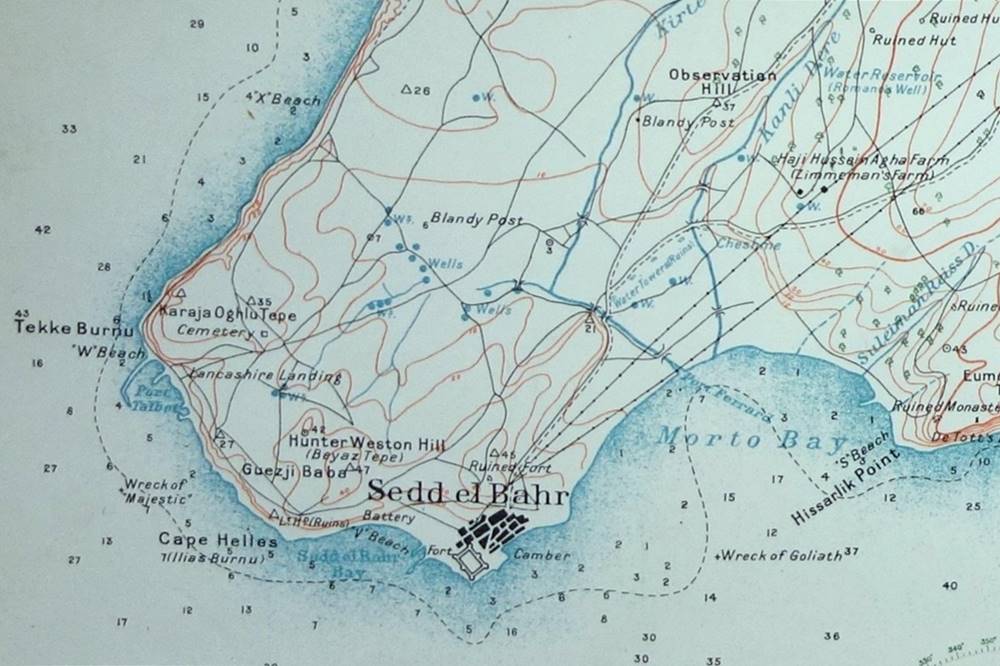This article looks at the grave of Charles Doughty-Wylie VC and is one of a number of articles I have written about Gallipoli. I have also created guides to help you research soldiers who served in the British Army during the First World War:
The Grave of Charles Doughty-Wylie
Lieutenant-Colonel Charles Hotham Montagu Doughty-Wylie, who was killed by a sniper on 26 April 1915, was a remarkable man and one of the most well-known soldiers to die at Gallipoli. Born in 1868, he left Sandhurst in 1889 and received a commission in the Royal Welch Fusiliers. He saw a great deal of active service, first on the North West Frontier of India, taking part in the Hazara Expedition in 1891, where he was severely wounded and subsequently in the Chitral Expedition of 1895. He then served in Malta and Crete (1896-8) and subsequently in the Mahdist War (1898-99) where he was present at the Battle of Khartoum. For his service in the Sudan, he received the Order of Medjidie. Shortly afterwards he served in the Second Boer War (1899 – 1902) where he was severely wounded and then in China, where he raised a Corps of Mounted Infantry. Doughty-Wylie’s last active service prior to the outbreak of war was in Somaliland (1903-04).
In 1904 he married Lillian Wylie and added his wife’s surname to his own. Before the outbreak of war, Doughty-Wylie met the explorer Gertrude Bell and the two wrote love letters to each other. (Doughty-Wylie was played by Damien Lewis in Herzog’s recent biopic of Bell Queen of the Desert). He was appointed the British consul in Mersina (Mersin on the southern coast of Turkey) where in 1909 he worked tirelessly and at great personal risk to stop a massacre of Armenians. The following account was published as part of an appeal for aid, in the Bedfordshire Mercury on 22 April 1910 by The Friends of Armenia:
Sir, To-day is the anniversary of the first massacre at Adana when, by order of the old regime, the Turkish mob fell on the Armenian population, and, with the aid of soldiery, put hundreds of innocent and defenceless people to the sword. This was followed by a more sanguinary outbreak on Sunday, 25th April, and in spite of the heroic efforts of our British Consul, Major Doughty-Wylie, about 6,000 people perished in the city of Adana alone, the entire number of victims of these April massacres mounting up to about 30,000.
The following is from Doughty-Wylie’s entry in Bond of Sacrifice which was taken from a column in The Times in May 1915:
On his own responsibility he assumed the practical command of the city of Adana, and his courage and capacity saved the lives of hundreds, indeed it was believed by those best able to judge, thousands, of many nationalities. Wearing his military uniform, he rode through the town with a half company of Turkish troops, compelling the raging mob to stop the killing, and posting guards over particular houses. His right arm was broken by a bullet, but this did not prevent him from riding out again, and in the second and worst outbreak of massacre again saving more hundreds of lives.
The ‘heroic Vice-Consul’ was the title accorded him. Sir Gerard Lowther, the then British Ambassador at the Porte, afforded him a generous need of support and encouragement, and Major Doughty-Wylie’s service were recognised by the ward of the C.M.G., and he also received the warm thanks of many foreign Governments and public bodied. He afterwards organised a system of relief to the destitute- 22,000 persons, exclusive of refugees in his own house, and exclusive also of the inmates of three hospitals which were managed by Mrs. Doughty-Wylie.
Doughty-Wylie was killed close to where he is buried, just beyond V Beach and is the only solitary grave maintained by the Commonwealth War Graves Commission on Gallipoli. It is known as the Seddel-Bahr Military Grave. Doughty-Wylie was awarded a posthumous Victoria Cross and his citation describes the events leading up to his death:
On 26th April 1915 subsequent to a landing having been effected on the beach at a point on the Gallipoli Peninsula, during which both Brigadier- General and Brigade Major had been killed, Lieutenant- Colonel Doughty-Wylie and Captain Walford organised and led an attack through and on both sides of the village of Sedd el Bahr on the Old Castle at the top of the hill inland. The enemy`s position was very strongly held and entrenched, and defended with concealed machine-guns and pom-poms. It was mainly due to the initiative, skill and great gallantry of these two officers that the attack was a complete success. Both were killed in the moment of victory.
The map below shows part of the Helles Sector with Doughty-Wylie buried just beyond the fort. Within a short walking distance of Doughty-Wylie’s graves are V Beach Cemetery, Lancashire Landing Cemetery and the Helles Memorial.


